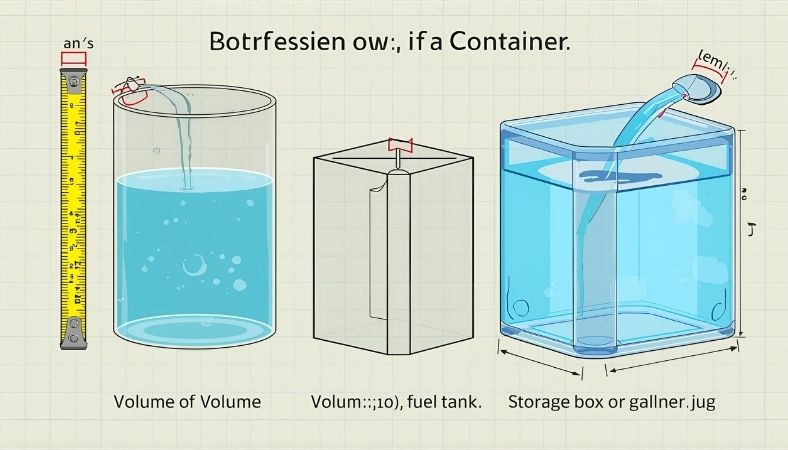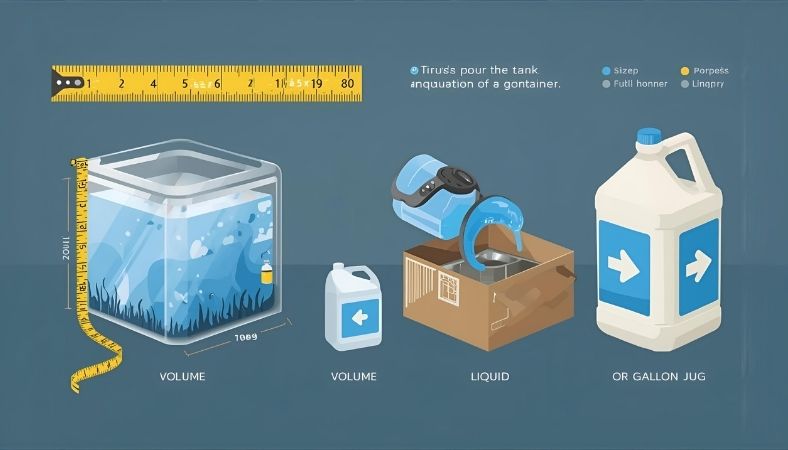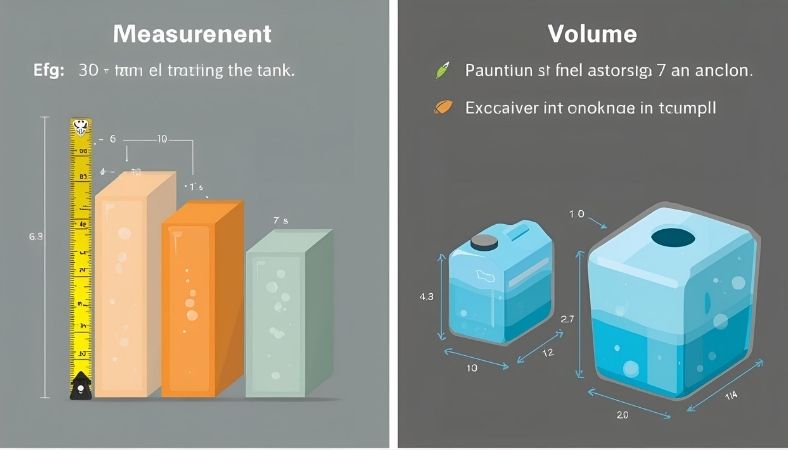Picture this: You’re setting up a sleek new aquarium for your goldfish, Bubbles. You’ve measured it 12 inches long, 12 wide, 18 high and you’re pouring water from a gallon jug. But halfway through, it’s overflowing, and Bubbles is giving you a side-eye. The culprit? You didn’t convert cubic inches to gallons. Don’t worry, we’ve all been there. This conversion is your secret weapon for avoiding soggy disasters, whether you’re sizing tanks, checking car engines, or collecting rainwater. Let’s crack it together, like we’re swapping tips over a coffee.
Key Takeaways
- Divide by 231 to turn cubic inches into US gallons—easy and exact.
- US and imperial gallons aren’t twins; the imperial one’s 20% bigger, so choose wisely.
- This math shines in real life, from aquariums to car specs.
- Skip common mix-ups by double-checking units and using handy apps.
- It’s not just numbers—it’s about saving time and avoiding messes.
What’s a Cubic Inch, Anyway?
A cubic inch is a tidy little cube, one inch on each side. Imagine a sugar cube, but for measuring space. It’s how we size up things like engine parts or the inside of a lunchbox. You’ll spot it in places where inches rule, like DIY projects or classic car manuals. One cubic inch equals about 16.4 cubic centimeters, but let’s stick to inches for now—you can grab a ruler and start measuring.
What’s a Gallon All About?
Gallons measure liquids, like the milk in your fridge or gas in your car. But here’s the twist: a US gallon (3.8 liters) is smaller than an imperial one (4.5 liters), used in places like the UK or Canada. Way back in 1706, England decided a gallon was the size of a specific wine barrel, and the US kept that vibe. You’re pouring gallons every time you fill a jug or a paint can, so knowing which one matters is key.
The Magic Formula: Cubic Inches to Gallons
Want to know the trick to converting cubic inches to gallons? It’s dead simple: divide your cubic inches by 231 for a US gallon. Got 462 cubic inches? That’s 462 ÷ 231 = 2 gallons. The number 231 comes from an old wine barrel standard—pretty cool, right? For imperial gallons, swap 231 for 277.42. So, 554.84 cubic inches ÷ 277.42 = 2 imperial gallons. Write it down, check your math, and you’re golden.
This formula’s your go-to for quick conversions. One cubic inch is roughly 0.004329 US gallons, so tiny spaces add up fast. Let’s say you’re packing a cooler for a picnic. Measure it in inches, multiply length times width times height, then divide by 231. Now you know exactly how many gallons of lemonade it’ll hold.
US vs. Imperial Gallons: What’s the Difference?
Here’s where things get sneaky. A US gallon holds 231 cubic inches, perfect for American fuel or soda. An imperial gallon, used in places like London or Toronto, fits 277.42 cubic inches—about 20% more. It’s like two cousins who look alike but have different appetites at the dinner table. Here’s a quick rundown:
- US gallon: 231 cubic inches, 3.785 liters, standard for US projects.
- Imperial gallon: 277.42 cubic inches, 4.546 liters, common abroad.
Mixing them up is a recipe for trouble. Imagine ordering a UK gardening sprayer in the US and using the wrong gallon—your pesticide mix could be way off. Always check the label or region to stay on track. This clears up the confusion folks often vent about online.
Where Does This Conversion Pop Up?
Think about setting up that aquarium for Bubbles. A tank 12 inches by 12 by 18 is 2,592 cubic inches. Divide by 231, and you’ve got about 11.22 US gallons. That’s how much water Bubbles needs to swim happily, without you mopping the floor.
Or picture your dream car with a 350-cubic-inch engine. That’s about 1.515 gallons of space where fuel and air mix to make it roar. It’s a neat way to grasp engine power without drowning in tech talk.
Then there’s rainwater. One inch of rain over a square foot catches 0.623 gallons. If you’re building a rain barrel, measure its cubic inches to know how many gallons it’ll store. A buddy of mine once built a barrel, miscalculated, and ended up with a flooded yard. Using this conversion saved his next attempt.
Even in cooking, this matters. A recipe might call for gallons, but your pot’s measured in inches. Convert it right, and your homemade cider won’t overflow. It’s practical math that saves the day.
How Many Cubic Inches Are in a Gallon?
This is a question folks ask a lot, and it’s simple: a US liquid gallon is exactly 231 cubic inches. For imperial gallons, it’s about 277.42 cubic inches. Dry gallons, used for stuff like grains, are 268.8 cubic inches, but they’re rare. If you’re dealing with water or gas, stick to 231 for US projects. Knowing this helps you reverse the math if you’re starting with gallons.
What About Converting 1,000 Cubic Inches?
Got 1,000 cubic inches? For US gallons, divide by 231, and you get about 4.329 gallons. For imperial, it’s 1,000 ÷ 277.42, or roughly 3.604 gallons. This is handy for small containers, like a cooler or a vase. Just measure carefully, and you’ll know how much liquid fits. It’s a quick trick for planning without guesswork.
Can You Convert to Dry Gallons?
Yes, but it’s less common. A US dry gallon, used for things like flour or apples, is 268.8 cubic inches. So, divide your cubic inches by 268.8. For example, 537.6 cubic inches is 2 dry gallons. Most folks deal with liquid gallons, but if you’re measuring grains, this keeps you accurate. Check if your project specifies dry or wet to avoid slip-ups.
Watch Out for These Common Slip-Ups
It’s easy to mess this up, but don’t sweat it—we’ve got fixes. First, mixing US and imperial gallons can throw you off by 20%. Picture a guy in the US ordering a UK fuel can, thinking it’s the same size. He underfills it, and his lawnmower sputters. Solution: Note your region and use the right number—231 or 277.42.
Another hiccup? Visualizing volumes. A gallon sounds small, but it’s a cube about 6.1 inches per side. Think of a milk jug to picture it, or stack six-inch Jell-O cubes in your mind. That helps your brain grasp the size.
Math mistakes happen too. Dividing by 231 isn’t hard, but rushing can lead to errors. Break it down: measure, multiply for cubic inches, then divide. If 1,728 cubic inches (a cubic foot) equals 7.48 gallons, use that to check if your answer makes sense.
I once saw a Reddit thread where someone botched a DIY cooler project by mixing inches and gallons wrong. A quick double-check with a calculator saved their next try. Keep it simple, and you’ll dodge these traps.
Tools to Make It Easy
Why stress over math when apps can help? Sites like Omni Calculator let you type in cubic inches and get gallons instantly, for both US and imperial. They’re free and fast, perfect for quick checks on your phone.
Manual math builds your brain, but digital tools save time. For big projects, like sizing a warehouse of containers, apps are a lifesaver. Just make sure your measurements are spot-on, and pick a tool with good reviews.
Pro tip: Some converters show the steps, so you learn while you go. Search “cubic inch to gallon converter” next time you’re stuck, and you’ll be sorted in seconds.
A Quick Peek at the History
Ever wonder why we use these units? Cubic inches go back to the 1824 imperial system, built on old English ways to measure space. Gallons started with wine barrels in 1706, and the US locked in 231 cubic inches by 1836. Fun fact: a gallon of water weighs 8.33 pounds, which is why carrying big jugs feels like a workout.
These units stuck around because they’re handy for specific jobs, even as liters take over elsewhere. Knowing the backstory makes the math feel less like a random chore.
Wrapping It Up
You’re now armed to tackle cubic inches to gallons like a pro. Whether it’s saving Bubbles’ aquarium, sizing a rain barrel, or understanding your car’s engine, this conversion is your shortcut to getting it right. Next time you’re measuring something tricky, grab a ruler, divide by 231, and watch the magic happen. Try it out on your next project, and you’ll wonder why it ever seemed hard.





